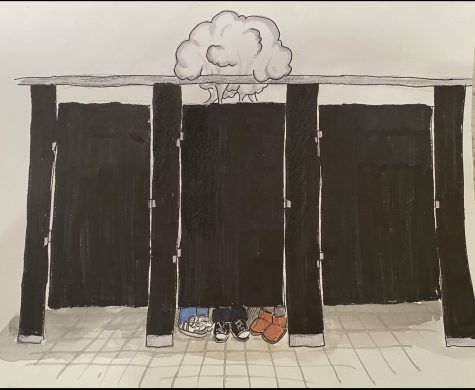Going cell-phone free for a day
April 1, 2015
About 4 years ago, I watched a video that had been posted on a frequently viewed Youtube channel. The channel, called SantagatoTv, is run by a young guy in his 20s, who uses humor to discuss events in his life, or common trends among teenagers and people his age. One particular video was titled “The iPhone Epidemic,” a preview of an ‘epidemic’ that he himself had already been exposed to. The video was effectively tagging the growing popularity of iPhones as a disease – crippling and overpowering, and quickly spreading, like a red and blotchy skin infection.
I was a freshman when I first saw this video; four minutes long and eerily accurate the same number of years later.
I got my first iPhone my sophomore year of high school, after reaching the point where it was rare to meet a person texting on a horizontal keypad, or a person sending those distinctive green text messages rather than the typical blue iMessages. From there, I followed the common series of symptoms of the iPhone epidemic: I became consumed, I became a professional photographer, and I increased my texting speed incredulously – an honorable series of events.
Some people have grown bored of the cell phone, and/or bored of the iPhone. Even so, we can still get caught up in the ever-growing collection of apps and addictive games. Whether I have outgrown it or comprehended the repetitive nature of the iPhone, I find the constant updates and new social media to be predictable and relatively uninteresting. But it does have one strong tool at its disposal: the iPhone is addictive.
That being said, the effects of this epidemic seem somewhat permanent, on myself, as well as other victims.
The teacher of my Topics in Literature class, Ms. Mason, has addressed this within her classroom. We have had a number of conversations and debates about the effects of not only iPhones, but technology – including music, laptops, and tablets – on the people who use them. One way that she had us look at the effects of technology was by eliminating it – actually taking away our cell phones for the day.
“I thought it would be interesting to see how their interactions would change if they didn’t have their phones as a crutch for the day, and to actually see if students would go along with the experiment,” Mason said.
This was an entirely voluntary assignment that more than 2/3 of the class participated in. We dropped off our cell phones to Mason before 1st period, mournfully and sorely for most, and left them in a beeping and ringing plastic bag in her closet for the full school day. Mason herself participated in the assignment.
8th period that day was an exciting one – from the discussion to the moment when we all were given our precious phones back, and were able to spend 5 minutes scrolling through our messages, Twitter feeds and Snapchats.
“Students talked about how their days were different, how they were annoyed with people bumping into them or ignoring them in the halls, how distracted their friends were, or how they realized just how often they were on their phones. Just the fact that the activity got students thinking about their own use of technology and their own distractions made it successful in my eyes,” Mason said of the class discussion held that day.
The little experiment actually made many students very happy. Sometimes just the simple presence of our phones in our side pockets can, shamefully, be tempting. During this day, every time I thought about reaching for my phone I knew that I did not have that choice. It was about conditioning myself to not think about reaching for my phone. Instead of being consumed by our virtual conversations, my fellow participants and I were forced to be fully invested in our spoken interactions, or the people we were with. We became distraction free, which proved to be a gift for most.
“The assignment was incredibly eye-opening. Even if it was just for a single day, we listened to what was going on around us rather than listening to our phones,” Natalie Pierce, Div. 582, a student in the class, said.
If anything, the activity forced us to think. It was unusual, it was sometimes frustrating, and as it was the first time that my teacher had done anything like this, it was definitely a risk. But for one day it was effective; it got 25 kids off of their phones and into their lives.
“Getting someone to think about their own actions for even a minute can make a change,” Mason said.
It did not kill the epidemic, which is spreading at a terrifying pace. It is a possible treatment; a suggestion at the least and I do suggest you give it a try – and maybe try longer than 8 screen-less hours.








